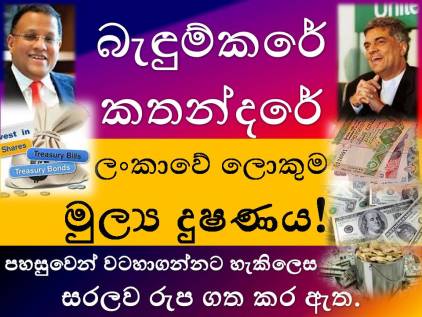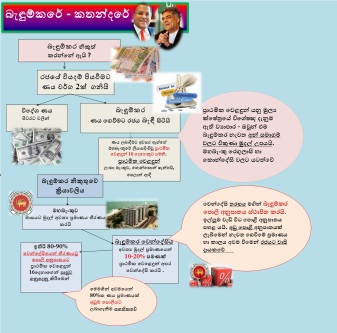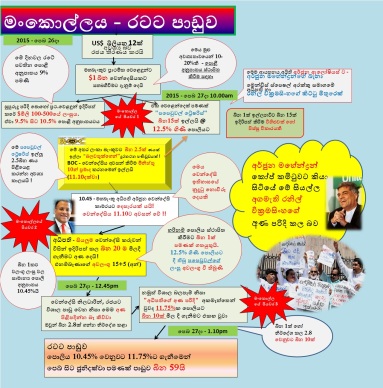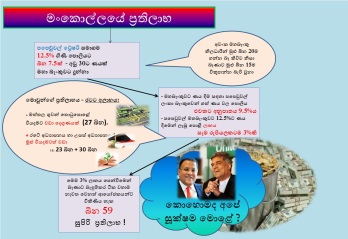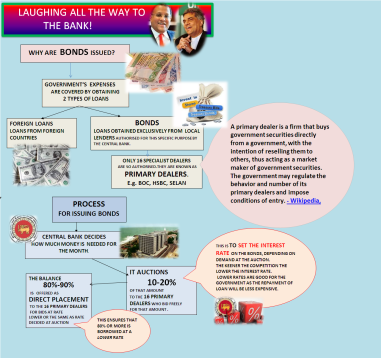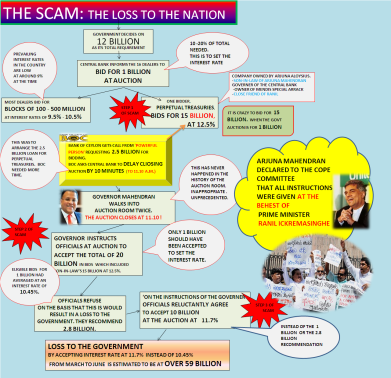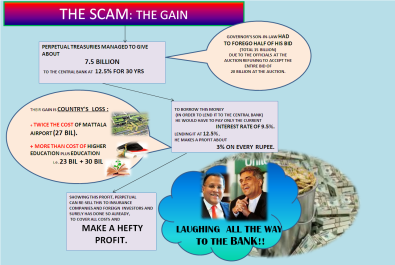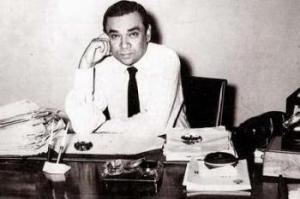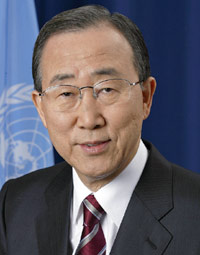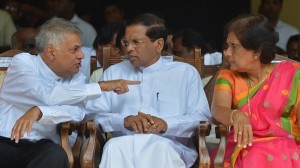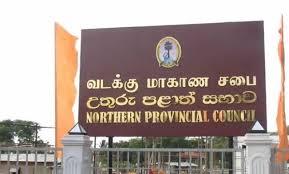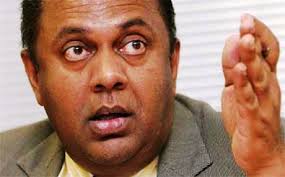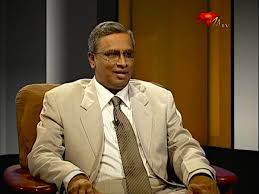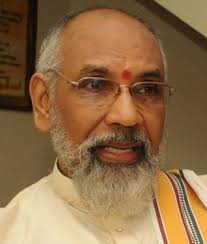Recomposing the Maithri-Mahinda-Ranil-CBK equation
by Dr. Dayan Jayatilleka
Who was it who narrowed the gap between President Sirisena and ex-President Rajapaksa? Whose efforts were strong and effective enough to override the wishes of the external consortium that backed the peaceful ‘regime change’ of 8 January? Was it the SLFP establishment, i.e. its top bureaucrats and old warhorses? Was it Basil Rajapaksa? Was it the Buddhist Sangha? Or could it have been the Chinese?
Not really. It was Prime Minister Ranil Wickremesinghe, whose political behaviour in the short period in which he held office was so polarising that President Sirisena felt the ground shifting beneath him and was forced to act to re-stabilise the situation.
Of course Ranil Wickremesinghe has done it before. Having won a Parliamentary election in 2001, he acted in such an arrogant, anti-national and polarising manner that an earlier SLFP President, Chandrika Bandaranaike Kumaratunga, was pressurised by nationalist backlash and a centre-left patriotic bloc of the JVP and SLFP, to throw him out.
Then it was Chandrika, this time it is Maithri. The latter hasn’t thrown him out but has grudgingly assented to a reunification of the SLFP as well as the broader anti-Ranil forces, and signed off on the return of Mahinda Rajapaksa to the centre stage of the SLFP, thereby virtually guaranteeing the defeat of Ranil Wickremesinghe.
Ranil and the UNP
Not having learnt a lesson from the disastrous experience of 2001-2003, Ranil, heading an even more vulnerable (minority) government than on the previous occasion, moved far too fast, on far too many fronts and in entirely the wrong direction. His conduct was accompanied on the external front by the outrageously pro-western policy of Minister of External Affairs, Mangala Samaraweera, and paralleled on the Northern front by the TNA’s cocky MA Sumanthiran and the raucously adventurist Northern Provincial Council.
Instead of building consensus and adopting a cautious gradualist approach, as any sensible Conservative would and as befits a minority government, Ranil and his UNP went for “shock therapy” and the “big bang” with truly evangelical zeal (the pun is intended). This unholy alliance and its adventurism were cheered on from the sidelines by a chorus of Colombo’s cosmopolitan civil society—a stratum that is so deracinated, so “high on its own supply”, that it cannot feel the rumble or hear the sounds of a huge nationalist-populist mass movement beneath its feet.
One result of Ranil’s ‘good governance’ was downright bad economic governance—the bond scam, stagnation on the economic development front, a downturn of the local currency and a shedding of jobs. The other outcome was a patriotic-nationalist backlash. The Mahinda revivalist movement sprang from and fed into the confluence of these two currents. Matters were sharpened by the witch-hunt of SLFPers and former officials, by the newly established police agencies. This came on top of the shift in Sinhala opinion. 
Mahinda Rajapaksa himself operated cannily in the narrow political space available to him after he had given the SLFP over to President Sirisena. He stayed off the political grid –leaving that to the Quartet or rather, the Four plus One, of Dinesh, Wimal, Vasu and Udaya, plus Dulles. Meanwhile Mahinda Rajapaksa himself operated in the non-party political space, on the socio-cultural grid: the temple network. This was possible because of the rising tide of Sinhala Buddhist sentiment.
Shift in public opinion
Thus President Sirisena felt the shift in public opinion among those he ruled and had sprung from: the popular masses of the Sinhala heartland. More: he felt the ground shift within his own party, the SLFP. He is now moving to recover that ground, but to do so he has to share it with its principal occupant, Mahinda Rajapaksa. In so doing has he betrayed the mandate of 8 January? That rather depends on what you think that mandate was, what you think of it—was it good or bad?—and whether or not you think it should have been fulfilled in totality.
I would argue that the progressive aspect of the mandate of 8 January was fulfilled with the passage of the 19th Amendment in its final, moderate form—the form the UNP is on the record as defining as inadequate and as a halfway house to complete abolition of the executive Presidential system.
North-south political reconciliation
One may ask what of that part of the mandate that was for post-war political reconciliation between north and south? No ethnic reconciliation is possible unless it has the broad support of the Sinhala majority. It cannot proceed under the administration of a leader such as Ranil who is heavily mistrusted by the majority as pandering to minoritarianism. This is one of the lessons of 2001-2003.
Therefore a sustainable political reconciliation between south and north requires as a prerequisite, a political reconciliation between the two tendencies of Sinhala patriotism as exemplified by the two wings of the SLFP: the liberal democratic reformist as represented by President Sirisena and the populist-nationalist as represented by ex-President Mahinda Rajapaksa.
Systemic stability
From the viewpoint of systemic stability, it is eminently sensible that President Sirisena prefers ex-President Rajapaksa’s independent mass movement, with its radical populist and nationalist ideology and consciousness, “on the inside pissing out than on the outside pissing in” (as US President Lyndon Johnson so famously put it about an opponent he had chosen to accommodate).
Maithripala Sirisena has just channelled a rising nationalist revolution from below, into the safer reservoir of reformist SLFP politics, just as S.W.R.D. Bandaranike channelled a social revolution from below, namely the ‘Hartal’ of August 1953, into the safer, calmer waters of left-of-centre parliamentary politics.
Also from a systemic point of view, it is eminently sensible that President Sirisena takes his distance from Prime Minister Wickremesinghe who was pulling too far to the right, in his domestic, ethnic and external policies. This partial de-linking from Ranil and the hesitant re-incorporation of Mahinda Rajapaksa is the only way in which President Sirisena can re-balance the equation and get back to the most vital real estate: the middle ground.
By the strategic move of accommodating Mahinda Rajapaksa and reunifying the SLFP instead of losing most of it, President Sirisena has made himself more popular in the country’s heartland; not less so. He has broadened his base.
The Gaullist Presidency of 1978 is eminently suited for the purpose of power balancing; indeed it needs to constantly balance in order to rise above the fray. By his new move, President Sirisena shows that he understands this.
What then of CBK?
What then of another ex-President Chandrika Bandaranaike Kumaratunga? She was an “accidental President” who won massively in 1994 simply because her UNP rival, the dynamic Gamini Dissanaike was blown up by a Tiger suicide bomber and she ran against his widow. She won again in 1999 because she faced Ranil Wickremesinghe rather than Karu Jayasuriya.
CBK played a deft hand by nudging Ranil Wickremesinghe out of the presidential candidacy and coaxing Maithripala Sirisena into the fray as common candidate. She failed since, because she lacks concentration and because of her own ideological confusion and political fickleness (reinforced by politically ignorant advisors).
She should have kept Ranil on a tight leash, but did not do so. Instead she played Ranil’s game by trying to keep President Sirisena on a tight leash. She also went out on a limb on the ethnic issue, publicly commending a federal constitution. Instead of balancing off Ranil, she took the most popular political personality in the country—indeed the single most loved person in the country—Mahinda Rajapaksa, head on. Thereby she evaporated her own potential appeal, and by so doing, reduced her own utility to and claims on Maithripala Sirisena. In short she became at least as much a liability as an asset to him among the SLFP rank and file and the Sinhala Buddhist masses.
CBK could have represented the liberal current of the SLFP, while Mahinda represented the populist and Maithripala the centrist, but she chose instead to position herself as the UNP within the SLFP. In the final round she has been seen to be obstructive towards and destructive of SLFP unity while Maithri and Mahinda have been seen to be willing to make compromises and sacrifices for the sake of party unity—and implicitly, the unity of the party’s Sinhala social base.
Maithri-Mahinda détente
Maithripala Sirisena represents the 8 January movement of reform from above, while Mahinda is buoyed by the 18 February movement (from Nugegoda to Matara) of populist-nationalism from below. Notwithstanding its bristling contradictions, the Maithri-Mahinda détente has caused these two movements and moments to intersect.
Ranil has been beaten twice by centre-left SLFP candidates: CBK in 1999 and Mahinda in 2005. Put differently, every time Ranil faced centre-left SLFP personalities he lost, and whenever the UNP fielded him against such personalities, the UNP lost and the SLFP won. He is unlikely to be third time lucky. Ranil fought Mahinda once in 2005 and lost and avoided him twice in 2010 and 2015. Now he is back in the ring with Mahinda, with no place to hide.
The Mahinda of 2015 is not the Mahinda of 2005 who beat Ranil. He has grown to be the leader who beat Velupillai Prabhakaran, reunified the country and went on to modernise the foundation of Sri Lanka’s economy. He is a much bigger figure—a “history making” man—than he was a decade ago.
This time around the Ranil Wickremesinghe administration was and is a minority government in several senses and dimensions. It not only had no majority in Parliament, it is perceived as a government by the minorities, for the minorities and of the minorities. The ideological subtext of the slogan ‘Bring Back Mahinda’ was ‘Let’s Take Back Our Country’/’We Want Our Country Back’.
UNP is bound to be overthrown
The UNP is bound to be overthrown at this election, which is already shaped up as the successor to the Silent Revolutions of 1956 and 1970. President Sirisena sees this coming. Why else would he shift to a policy of rapprochement with Mahinda Rajapaksa and his mass movement? President Sirisena has been very prudent, indeed quite canny, to step nimbly out of the way, and position himself on the safe side of a social tectonic shift and an electoral tsunami that is less than six weeks away. As in 1956 that tsunami will sweep away a social elite and its project.
The geopolitics of the electoral map of 8 January already showed the bedrock strength of Rajapaksa and the potential for the defeat of the UNP. Now, at the time of nominations, Ranil has already walked the UNP into an electoral Nandikadal; a ‘killing box’. It can recover from the inevitable electoral carnage only if, on the morning after 18 August it does what it should have done some years ago—install a populist leader.
I recall with no little amusement the definitive relegation of Mahinda Rajapaksa to a ‘marginal cult figure of Sinhala ultra-nationalism’—at best a third force, behind the UNP and the official SLFP; desperately pining for but incapable of being a serious contender once more. These pseudo-intellectual observers and commentators forgot the single most important factor in politics: the masses of people; the vast multitude.
“Politics begin where millions of men and women are; where there are not thousands, but millions, that is where serious politics begin” remarked Lenin sagaciously (March 1918). Across the island’s heartland where millions live, the masses have carried Mahinda back to the centre stage of politics. What a comeback it has been, in just six months!
Courtesy: The Daily FT
– See more at: http://www.ft.lk/article/444173/Sirisena-shift–Maithri-Mahinda-moment?#sthash.1NCcyPbE.dpuf
BONDSCAM: SRI LANKA’S BIGGEST FINANCIAL FRAUD! CLICK ON THE SLIDES TO UNCOVER THE CROOKS AND HOW THEY PULLED IT OFF!
Mangala, The Diaspora & Postwar Peacebuilding
by Dr.Dayan Jayatilleka
As usual Sri Lanka’s cosmopolitan liberals have it wrong and that includes their most prominent personality, Minister of External affairs Mangala Samaraweera. His embrace of the Diaspora is wrong, not because the Diaspora is diabolical but because Mr. Samaraweera’s embrace is indiscriminate.
Sri Lanka must welcome its Diaspora or Diasporas (plural). This is true of us as a country as well as of the Government of Sri Lanka. But the Diaspora is not a homogenous entity. I do not mean that the Sinhala Diaspora is good and the Tamil one is bad. What I do mean is that there are extremists in both the Tamil and Sinhala Diasporas, just as there are moderates. The Government and the country should open its doors and roll out the red carpet for the moderate, enlightened currents of both Tamil and Sinhala Diasporas. The Government should go beyond that and strive to promote a truly Sri Lankan, i.e. Tamil and Sinhala Diaspora, by building bridges between the moderates, the progressives, of both sides. (Indeed this is the policy I practiced with some success when I represented Sri Lanka in France.) Instead, what Mr. Samarawera has done is to embrace the anti-Sri Lankan element of the Tamil Diaspora.
By anti-Sri Lankan, I do not mean anti-Mahinda Rajapaksa, because that is a matter of democratic political choice. Nor do I mean by anti-Sri Lankan, a generally violent discourse or disposition. After all, Mr. Suren Surendiran is a civilized chap and Fr. Emmanuel is quite affable, even warmly so. By anti-Sri Lankan I refer to an objectively verifiable political stance against Sri Lanka’s national interest. The evidence is out in plain view in the interview that Suren Surendiran of the GTF gave the state-run Daily News, AFTER the conciliatory meeting with Foreign Minister Samaraweera and the resultant conversion to moderation on the part of the GTF. In it he spells out the four pillars of GTF policy. If I may mix metaphors, the smoking gun is in pillar number 3:
‘…Explaining the third pillar, he said: “The third is to actively lobby and create awareness within the international community, international institutions and governments regarding the injustices and alleged breaches of international laws, including international human rights and humanitarian laws that amounted to war crimes and crimes against humanity. Lobby for international independent investigations of both sides…Surendiran said the GTF intends to carry out the Four Pillar Strategy “with the help of the people of Sri Lanka, in the Diaspora and the international community including India.” He added that since 2011, the GTF has been progressing under this programme.’ (‘GTF to work on four pillar strategy’ Kathya de Silva-Senarath June 16, 2015)
The problem with the Ranil–Mangala–CBK model of reconciliation and peace-building is that they have learnt nothing from their unsuccessful efforts of the dismal Decade of Appeasement 1995-2005. This is not to say that the Mahinda Rajapaksa administration got postwar peace-building and reconciliation right. Far from it: the first mistake made in that realm was to abolish the Secretariat for Co-ordinating the Peace Process (SCOPP) headed at the time by Prof Rajiva Wijesinha.
The Ranil-CBK-Mangala troika made the gross mistake of thinking that peace could be arrived at without the total military defeat of the Tigers and more basically, the elimination of Prabhakaran. Given that peace could not be arrived at even during the much less intense JVP insurrection of 1986-1989 without the elimination of Wijeweera and the defeat of the JVP, it took a really high degree of obtuseness to assume that it would be different with a far more fanatical, successful and powerful LTTE.
For its part the Rajapaksa administration made the opposite error. Just as Ranil-CBK-Mangala failed to realize that peace could not be achieved without a successful war; that a victorious war was a necessary precondition for peace; the Rajapaksa administration whose great merit was to recognize as their predecessors did not, that military victory was both possible and necessary, made the opposite error of assuming that a necessary condition was a sufficient condition. It thought that the victorious end of the war was a sufficient condition of a sustainable peace. It failed to realize that a process of peace-building was necessary, and that this peace-building required not only material reconstruction and development, not only de-mining and rehabilitation; but also political negotiation. It failed to understand that political negotiation, while a discredited tactic of appeasement when practiced in wartime by Ranil-CBK, was however, a necessary postwar practice and prerequisite for a sustainable, durable peace.
Ranil-CBK-Mangala strove to achieve peace by talking to the wrong people: the fascist, fundamentalist Tigers and their fellow-travellers. They could and should have worked out a political project with the anti-Tiger/non-Tiger Tamil groups and caught the Tigers in a politico-military pincer, but they did not. They could have implemented the 13th amendment instead of wasting time and political capital with the union of regions packages of 1995 and 1997, the Liam Fox agreement and the CFA, the Solheim mediation, the PTOMS etc. They could have appointed an interim administration within the 13th amendment and installed a coalition of progressive anti-Tiger Tamil groups which had worked with the UNP earlier and knew CBK from her SLMP years. But they did not.
For their part, the Rajapaksa administration could have done what President Putin successfully did in Chechnya with Ramzan Kadyrov, and empowered their ally Douglas Devananda in 2009, as the war was won and before the TNA recovered. Instead it opted for a (hyper-securitized) developmentalist strategy which had as a political component, a vain effort to rebuild the SLFP in the North and East.
Interestingly, CBK and MR administrations had the same option and made the same mistake: they both had an anti-Tiger, anti-secessionist Tamil partner which they had inherited from the Premadasa–Ranjan Wijeratne years, but they failed to play that card. CBK preferred to talk to the fascist Tigers (through the Norwegians) even after they tried to kill her and instead, blinded her in one eye.
The Rajapaksa administration correctly understood the fascist character of the Tamil Tigers and defeated them, but having done so it strove in the postwar phase, to operate politically in the North without any identifiable Tamil partner and strategic ally. Having made that mistake, the Rajapaksa administration compounded it by allowing the default option to fail, in that the dialogue with the TNA broke down and stayed suspended.
Mangala Samaraweera has picked up where Ranil, CBK and he left off. If the GTF is “moderate” according to Mangala, we can imagine what his idea of radicalism is. What the Sri Lankan government—any Sri Lankan government—should do, is to adopt, in its Diaspora outreach, a policy of concentric circles, which privileges the anti-Tiger, anti-secessionist elements of the Tamil Diaspora before reaching out to those who were Prabhakaran’s fellow travellers, and still refuse to criticize him or the LTTE. No Government should embrace those who, even after dialogue, boast that one of the pillars of their policy is to lobby the international community including governments, for international investigations into ‘war crimes’ and ‘crimes against humanity’.
The basic task of any Foreign Minister and Foreign Ministry should surely be to oppose, refute, rebut and defeat those Diaspora elements who threaten our national sovereignty by lobbying for international war crimes inquiries against Sri Lanka (and in a fraudulent even-handedness, the dead Tigers). If only in his capacity as this country’s Minister of External Affairs, Mangala Samaraweera should be far more discriminating in whom he chooses to partner with in external affairs.
Courtesy:
ColomboTelegraph
Mangala and Ranil Deviate From “Kadirgamar Doctrine”of Continuity,Engagement and Change Towards China,India and US Led West
By DR DAYAN JAYATILLEKA
The title of the news story which broke in the Japanese media last week was entitled “FM: Sri Lanka to dilute dependence on China.” Any credible, substantive contradiction of the content of this report (and not just its title) by our Foreign Ministry must not take the form of remarks to the local press but a formal contradiction/correction seeking publicity in the (respected) Japanese media giant, the NHK, which carried the original story. The story says:
“Sri Lanka’s foreign minister says the country will review its China-dependent foreign policy and boost ties with other nations. Mangala Samaraweera held an interview with NHK on Thursday. He is visiting Japan for the first time since the current government was launched under the new president, Maithripala Sirisena.
Sirisena won a presidential election in January by defeating the incumbent, Mahinda Rajapaksa. Rajapaksa promoted a foreign policy that relies on China. Foreign Minister Samaraweera referred to Sri Lanka’s relations with China. China overtook Japan as Sri Lanka’s biggest source of assistance in 2009.
He indicated that Chinese aid led to rampant corruption under the previous government. He said the Sri Lankan government has suspended a project to improve port facilities in the nation’s largest city, Colombo, and is now reviewing it. He added the project may not have followed appropriate procedures…”(http://www3.nhk.or.jp/nhkworld/english/news/20150619_09.html)
Going by their pronouncements during the election campaign and in office, Messrs. Wickremasinghe and Samaraweera are clearly unaware of or incapable of understanding, among other things, the difference between “dependent” and “reliant” i.e. between a satellite and an ally. If Sri Lanka tilted to China rather than the US or India, Mr. Samaraweera must know why that was, when it took place or began, and who the architect of that policy was. He must realize that such a reliance or ‘tilt’ was consonant with Sri Lanka’s vital national interests. He obviously does not know any of this.
While the villain of Mr. Samaraweera’s tale, Mahinda Rajapaksa of Medamulana, was still an Opposition MP, Sri Lanka under a UNP administration of a President who was so pro-US that his nickname was Yankee Dicky, was to learn a harsh lesson in the limits of US and Western support in our hour of greatest need. While the US was waging a proxy war of cross-border terrorism against the elected Nicaraguan government, and was helping in the counter-insurgency campaign of the blood soaked Salvadorian military, it had strict limitations on the military support it would extend the pro-western UNP government of JR Jayewardene.
Part of the reason was of course India, but that isn’t the whole story or even the most fundamental part of it. The proof is that even when Sri Lanka had a government that was exceedingly friendly with India, such as the Chandrika Bandaranaike Kumaratunga administration, neither the West nor the Indians gave us anything remotely like the military assistance that we as a democratic state, deserved and imperatively needed, to defend ourselves from the globally networked and heavily armed Tamil Tiger terrorist militia.
The deeper, abiding reasons were and are (I) the social, cultural, psychological and geostrategic weight of 80 million Tamils (factors which must not be reduced to mere voting strength) (II) the ambiguity of US-UK commitment to the concept of national sovereignty (apart from its own) and (III) the importance of the global human rights constituency in Western society and human rights discourse in Western ideology.
Thus it was that Sri Lanka’s finest foreign minister, Lakshman Kadirgamar decided on a policy reorientation that would combine continuity, engagement and change. The ‘continuity’ aspect was to build upon Sri Lanka’s traditionally excellent relations with China. The ‘engagement’ aspect was the continuing friendly dialogue with the West, especially the USA. The ‘change’ was that while being close friends of both, Sri Lanka would not be strictly equidistant between India and China, but would balance off India and the West by relying increasingly upon the East; relying upon and imperceptibly tilting towards China.
The Kadirgamar doctrine was part of a broader shift which (a) opposed President Chandrika Kumaratunga’s attempt to induct Maarti Ahtissari as a peace facilitator in Sri Lanka’s conflict (b) dissented from Chandrika’s PTOMS and (c) reached out to the (Weerawansa-ist) JVP as a pressure group (he arranged for the JVP to visit China annually). Interestingly the two individuals who were knee-deep in the Ahtissari and PTOMS moves respectively, are currently serving in sensitive posts in the Yahapalana regime, while Mangala Samaraweera who repeatedly urged a reluctant Kadirgamar to enter into a low-key dialogue with the TRO (Tamil Rehabilitation Organization)—a ‘conversation’ that strangely coincided with the last few months of his life — is now Foreign Minister, in dialogue with the “international inquiry/accountability” boys of the Global Tamil Forum.
In the last year of his life, not only was Kadirgamar deeply alienated from Chandrika’s policy perspective but had rebuilt relations with someone he considered a rival for the Prime Ministership, namely Mahinda Rajapaksa. The symbolism was obvious when Kadirgamar’s choice as guest of honor at the opening of the new building of the Bandaranaike Centre for International Studies (the BCIS was originally established on a project report written by my father to Madam Sirimavo Bandaranaike in 1975) was not President Kumaratunga but precisely Prime Minister Mahinda Rajapaksa.
The building was declared open by the Prime Minister of China, Wen Jiabao. As a member of the Council of Management of the BCIS, I was present, and recall the occasion vividly. The day’s highlight was the unveiling of a sculpture of that “great internationalist, statesman and visionary, Chou En Lai” (as Lakshman Kadirgamar so rightly put it).
Kadirgamar’s speech on that occasion was the clearest expression of his China policy, which remains the finest exposition of a China policy issuing from an enlightened comprehension of Sri Lanka’s core national interests and its historical experience. It is superb example of the Realist/neo-Realist paradigm in foreign policy thinking. It indicates why Sri Lanka cannot be more reliant on India than on China or even be strictly neutral or equidistant between them.
This Kadirgamar line on relations with China, India and the methodology that Sri Lanka should use when charting its foreign relations, is the very perspective that Prime Minister Ranil Wickremesinghe in his Japan Times article, and foreign Minister Samaraweera in his various pronouncements and actions, have effected a rupture with, and turned their backs, on in their West-centrism.
In a speech which was officially distributed with a quote from the text which read ‘China, a benign and sincere friend of Sri Lanka’, here then is what Lakshman Kadirgamar had to say at the unveiling of the bust of the late Premier Chou En Lai at the BMICH on 9 April 2005:
“…When a relationship is based on mutual respect and affection, the size, importance and power of one of the two countries in that relationship does not have a disproportionate influence on the other. China has never sought to influence the domestic politics of Sri Lanka. Over the years China has proved to be benign and sincere with no ulterior motives for befriending Sri Lanka. She has never tried to dominate, undermine or destabilize Sri Lanka.
She has come to our rescue with timely assistance on several occasions when there were threats to Sri Lanka’s national security and territorial integrity…There have been no strings attached to Chinese aid. When a relationship between two countries is not based on dependence, it is strengthened by the fact that it is based on the mutual recognition of equality.”
This was the crux of ‘Kadirgamar Chinthana’ on China and by clear contrast and implication, India and the West. It signaled a well-reasoned preferential option for China.
In his speech Kadirgamar went on to say that with regard to Human Rights, Sri Lanka has been a “steadfast ally” of China.
“…Sri Lanka in its own way has been helpful to China. The rubber-rice pact of 1951 has been referred to. In more recent times Sri Lanka has in a modest way been of assistance to China in international fora especially in the field of human rights where Sri Lanka, taking the view that China was being unfairly treated in certain quarters, has been her steadfast ally. It is good for a relationship when both countries are able to contribute something towards sustaining and enhancing it. Sri Lanka has remained steadfast and unequivocal in respect of its One China Policy.”
This stands in contradistinction to the Ranil-Mangala perspective that China’s political values are authoritarian and alien to Sri Lanka, which is much closer to the values of the West. Kadirgamar’s stand is also at variance with our current stances in the UN, where Sri Lanka under Mangala Samaraweera actually voted with the USA against a resolution sponsored by Russia, China and India and supported by the whole of the South Asian region, with Sri Lanka as the sole outlier.
Kadirgamar’s speech indicates another basic value based view that Sri Lanka shares with China, which the West does not, as proved by its policy and practice on Kosovo, South Sudan and Iraqi Kurdistan (triggering retaliatory imitation on the part of Russia, in Georgia and Ukraine). I refer to the fundamental issue of anti-secession.
“We believe that Taiwan is an inalienable part of the People’s Republic of China – something which the United Nations has reaffirmed each year. We support China’s policy of peaceful reunification and China’s efforts to promote cross-straits links for the benefit of the Chinese people and their social and economic development. Sri Lanka has expressed its support for China’s recent anti-secessionist law…” (Ibid)
Perhaps most pertinently, the 2005 speech shows how utterly enthusiastically Kadirgamar viewed the economic rise of China, its impact on the world order and its implicit potential for Sri Lanka.
“It is in the light of these considerations that Sri Lanka observes with admiration China’s steady, peaceful ascent to the summit of economic power. Long may the People’s Republic of China flourish and prosper. Long may the friendship between China and Sri Lanka grow in strength and vigour.” (Ibid)
For their part, Ranil and Mangala are non-committal or tepid about the “ascent” of China to the world’s economic summit and have actually frozen the role and function of the mighty Chinese powerhouse as an economic motor force for Sri Lanka.
For decades Sri Lanka’s most respected analyst of world affairs, Mervyn de Silva argued that in the 1950s, Ceylon was on the verge of being incorporated by the UNP government into the US alliance system which was being built up against the Asian and Eurasian powers China and Russia. He asserted that it was Mr. Bandaranaike’s victory in 1956 that aborted this impending “disaster” and totally reversed direction:
“…Mr. Bandaranaike’s foreign policy, as evident in his adoption of nonalignment, his total identification with the Afro-Asian resurgence, the closing of the British bases in Trincomalee and Katunayake and the opening of embassies in Soviet Union, China and other Socialist countries. This contrasted sharply with the last phase of UNP rule. True to his publicly declared faith in the British, “our trusted friends”, DS Senanayake made Ceylon’s ‘foreign policy’, such as it was, an extension of Whitehall thinking. His son Dudley Senanayake did not effect any substantial changes…
Ceylon was represented at Bandung by Sir John Kotelawela, a brash anti-communist crusader perfectly attuned to the spirit of the Dullesian era. Ceylon was on the doorstep of CENTO when 1956 rescued our foreign policy from what would have been a disaster…
The cosmopolitan exhibitionism and vulgarity of the pre-’56 phase of the UNP made it an ideal target for the resurgent nationalism which fuelled the ‘cultural revolution’ of 1956. An equally sharp confrontation was seen in the field of foreign policy when SWRD Bandaranaike’s ‘Afro-Asianism” and ‘Non-Alignment’ offered a striking contrast to Sir John’s pro-American lurch at Bandung…” (‘April Anniversaries’, lecture by Mervyn de Silva at the Teilhard de Chardin seminar in April 1981, republished in ‘Crisis Commentaries: Selected Political Writings of Mervyn de Silva’ ICES, 2001, pp. 36-52)
Ranil Wickremesinghe’s announcement in the Japan Times that Sri Lanka would re-set its strategic position in the world; his and Mangala’s invocation of “trusted traditional friends” while turning away from China; their “pro-American lurch”, are not deviant behavior but a throw-back to the most disastrous phases of UNP foreign policy.
Courtesy: dbsjeyeraj.com
“U.S. has been interfering in Russia’s internal political processes”: Russian President Vladimir Putin
ST. PETERSBURG, Russia, June 21 (Xinhua) — Russian President Vladimir Putin Friday delivered a speech at the plenary session of the 19th Saint Petersburg International Economic Forum.

Russian President Vladimir Putin addresses a plenary session of the 19th St. Petersburg International Economic Forum in St. Petersburg, Russia, on June 19, 2015. (Xinhua/Jia Yuchen)
Before 7,000 government officials and business leaders, Putin gave his insight into a number of pressing issues that both Russia and the rest of the world are greatly concerned about.
CRITICIZING U.S. FOR LAUNCHING NEW COLD WAR
Putin slammed the United States in his speech for imposing its standards on Russia without consideration for Moscow’s interests.
By funding nongovernmental organizations, the U.S. has been interfering in Russia’s internal political processes and trying to force Moscow to accept its decisions on global issues, he said.
Putin stressed that the so called “new cold war” is not caused by local conflicts, such as the crisis in eastern Ukraine, but Washington’s decisions, including its withdrawal from the anti-missile defense treaty, which he believed would push both countries toward a new spiral of arms race.
It makes more sense for the two major powers to understand each other’s strategic interests and narrow differences via dialogue with the concept of non-conflict and non-confrontation, he said.
In this regard, Putin warned Washington not to “use the language of ultimatums” when talking to Moscow, while expressing the country’s willingness to restore bilateral ties and beef up cooperation in dealing with global challenges, such as terrorism, narcotics trade, and the proliferation of weapons of mass destruction.
HIGHLIGHTING ASIA-PACIFIC ROLE IN WORLD ECONOMY
Noting that the global economic landscape is changing, Putin said the Asia-Pacific region would become the primary source of growth over the next decade.
Following on the “inevitable” trend, Russia has been stepping up its cooperation with the region since last year, an important choice the country has made to offset the impact of Western sanctions against it and improve its economic structure, he said.
Putin mentioned in particular the cooperation between Russia and China, saying both sides are discussing the integration of Eurasian Economic Union framework with China’s Silk Road Economic Belt initiative, which is conducive to implementing major joint infrastructure projects, simplifying trade, and strengthening cooperation through various financial instruments.
CONFIDENT ABOUT RUSSIAN ECONOMY
Russia’s gross domestic product (GDP) flagged a 2.2 percent year-on-year fall in the first quarter of 2015, and the deficit is expected to reach 3.7 percent of GDP for the year as a whole, Putin said.
Nevertheless, the president did not shy away from his confidence in national economy. He said Russia has successfully weathered sanctions and prevented a very deep crisis.
The Russian economy has built up sufficient reserves to give it the “inner solidity” it needs, he said, citing that the country has absorbed short-term fluctuations, introduced import substitute plans, maintained a stable budget, and prevented a jump in unemployment.
EXPECTING TRUST-BASED DIALOGUE WITH KIEV
Putin reiterated that Russia should not be blamed for the crisis in neighboring Ukraine, saying it was the Western support to the “anti-constitutional coup” that led to a severe conflict and to a “civil war” in Ukraine.
He called on all concerned parties to completely fulfill the new Minsk agreement clinched in February, and called for direct dialogue between Kiev and the self-proclaimed Donetsk and Lugansk people’s republics.
Russia should exert influence over the conflicting sides in the country, Putin said, while urging the West to do the same.
He also voiced his hope that the crisis be resolved via negotiations, rather than violence, and expected to hold dialogue with Kiev on a trust-based, equal and comprehensive basis.
Russians and Ukrainians enjoy a common history, a common culture and common spiritual roots, thus they are doomed to a common future, Putin said.
Courtesy:
Chen Yue 丨Xinhua]
Chinese Foreign Policy: What to Expect in 2015
 Chinese President Xi Jinping greets guests at the signing ceremony for the Asian Infrastructure Investment Bank at the Great Hall of the People on 24 October 2014 in Beijing. Photo by Getty Images.
Chinese President Xi Jinping greets guests at the signing ceremony for the Asian Infrastructure Investment Bank at the Great Hall of the People on 24 October 2014 in Beijing. Photo by Getty Images.One of the most surprising aspects of Chinese diplomacy since mid-2013 has simply been the amount of time and energy the leadership has devoted to it. Xi Jinping looks more like a ‘foreign policy president’ than any of his predecessors – having travelled extensively and met a host of foreign dignitaries at home. Premier Li Keqiang has also been active internationally, particularly in dealings with Southeast Asia and Europe. As China’s rise on the world stage continues, what are the themes to look out for in 2015?
Given competing pressures on policy resources, the leadership’s high level of international engagement is in itself revealing. After the Communist Party’s key anti-corruption ‘campaign’ is taken into account, along with international diplomacy, it is hard to see much room for other policy priorities. As a result, domestic economic reform has been taken forward in a largely technocratic and politically low-key manner.
The attention to foreign policy has underpinned some notable developments. In June 2014 China hosted the Conference on Interaction and Confidence-Building Measures in Asia (CICA), a hitherto little-known institution whose membership stretches across Eurasia. This prompted speculation that China was trying to boost an Asian regionalism that excludes the US. Such concerns, however, were mitigated by Beijing’s hosting of the APEC summit in November and by the successful meeting between President Xi and Barack Obama, which resulted in bilateral agreements over carbon emissions, technology and military communication.
China’s international policy has for a while been balancing engagement with the existing international order and a growing element of gradual ‘revisionism’ – that is, practical efforts to reform that order. We saw more of the latter in 2014. Particularly significant was Beijing’s launch of a new development bank, the Asian Infrastructure Investment Bank (AIIB), though the US persuaded several key countries not to participate.
The AIIB ties in with the agreement in July 2014 to establish a new ‘BRICS’ development bank (called New Development Bank) and Beijing’s plans for a Silk Road Fund to finance China’s promotion of land and maritime trade routes (though the ‘silk road’ policy is more a repackaging of existing trends in Chinese engagement across Eurasia than a completely new initiative).
None of these initiatives is unilateral. Yet taken together, they constitute more proactive steps to reform the international order than China has attempted previously. In the aftermath of the global financial crisis of 2008–09, Chinese revisionism had been more modest in scope, directed towards increasing the country’s vote in international financial institutions and supporting the G20.
Still, these steps do not have to be seen as an effort to establish an alternative order, a Pax Sinica of the sort predicted by those who look back to Qing dynasty regional hegemony for inspiration about China’s future relationships in Asia. China remains strongly engaged with post-1945 institutions. In some ways its approach to international relations harks back to an idealized post-war global order embodying non-interference and the sovereign equality of states. Hence Beijing’s emphasis on the role of the United Nations in international decision-making.
Xi’s speech at a domestic meeting on foreign policy in November 2014 sheds some light on the leadership’s intentions. The tone was softer than previously, and the main message was one of policy continuity. Xi talked about ‘reform’ rather than revision of the international order, with no hints that China is preparing for a global leadership role or envisages exceeding the US’s power any time soon, even as its economy approaches that of the US in size.
What does all this mean for international affairs in 2015?
Firstly, China’s economic diplomacy will grow in scale and geographical scope. It is this – rather than compromise on long-standing positions – that Beijing is likely to try to use to repair relations in the region which have been damaged by maritime disputes (though such tactics may not work). Given the lack of trust over security issues, and the difficulties Xi has had in getting US buy-in for his ‘new type’ of bilateral relations, economics may also increasingly be the focus of China’s approach to the US.
Secondly, we should expect more soft revisionism from China, pushing for reform within existing institutions and for alternatives when the appetite for reform is not there. This means that Chinese policy in 2015 will depend to a significant degree on the approaches of others, particularly the US. By opposing the establishment of the AIIB, the US missed an opportunity to demonstrate that it is not trying to contain China’s rise.
Thirdly, expect ongoing realignment in China’s partnerships. This has been taking place quietly on the Korean peninsula, with relations between Pyongyang and Beijing the coolest yet. It is also evident in China’s rebalancing of its diplomacy away from Pakistan and towards India. China will continue to prioritize its relationship with Russia, though Chinese leaders will remain cautious about providing explicit support for Vladimir Putin’s own revisionism, very different from China’s in style and substance. Western Europe will remain lower down the list of priorities.
One area where realignment is unlikely is in China’s troubled relationship with Japan. The November meeting between President Xi and Japan’s Prime Minister Shinzo Abe left relations at the end of 2014 looking better than they were at the beginning of 2014. But the fundamentals have not really changed, even though there remain good reasons to doubt predictions of military conflict.
In sum, Chinese foreign policy this year will merit careful attention.
courtesy: http://www.chathamhouse.org
BENDING OBLIGINGLY:THE WESTERN-ORIENTED ELITE & INTELLIGENTSIA
By MERVYN DE SILVA
16th Death Anniversary of Mervyn de Silva – June 22
(Excerpted from the multi-part ‘Politics Today’ think-piece “1956: The Cultural Revolution That Shook the Left” and “The Left Awakens from Romance to Reality”, full-page articles published in the Ceylon Observer Magazine Edition, May 16th & 23rd, 1967, Mervyn de Silva’s essay was a retrospective of 1956, a prefiguration of the broad anti-UNP center-left Opposition front of 1968 and a prospective signal of the fall of the rightwing pro-western government in 1970, three years after its publication. A critical reconsideration of postcolonial society, it was also a pioneering auto-critique of the Westernized elite and English-educated cosmopolitan intelligentsia of the Right and Left by one of the most discerning intellects and striking personalities of that milieu. It contained the suggestion of a possible synthesis, a third politico-cultural and intellectual sensibility and stance. At the time, Mervyn was 37 years old.—D.J.]
In the national process, 1956 is the crucial turning point. What was the historical nature and content of this event? The 1956 movement, spearheaded by the rural middle classes and the Sinhala Buddhist intelligentsia was an anti-privilege impulse directed against the English educated establishment. It had a dual character: culturally revivalist (languages, religion, customs, dress, etc.) and economically radical, or it is loosely termed now, “socialist’. An historical oddity, it did not come as in many other colonial countries as an integral part of an independence or national liberation struggle.
The singular characteristic of a genuine mass movement is not only that it becomes the physical expression of the mass mind in action but that the popular will continuously impresses itself on the leadership, pushing and patterning it to the often inarticulate though feverish needs of the masses. In India there was such an active commerce between the people and their leaders; a constant flow of sympathy between the masses and the upper classes which provided leadership; a unity forged on the anvil of mass action.
Total Surrender of Our Upper Classes
In little manageable Ceylon, colonialism meant both the spoliation of traditional culture and the total surrender of our upper classes to the alien’s “superior” way of life. In the say of resistance, there were few lonely voices—the stirring indictments of a Dharmapala, the patriotic polemics of a Piyadasa Sirisena, the purist ardour of a Munidasa Kumaratunga, the sublime if little known, promptings of an Ananda Coomaraswamy. In the main, though, the foreigner took the Ceylonese upper class by the scruff of its neck, scrubbed away the native mud, dressed it top hat and tails, tutored it in table manners and taught it that the umpire’s word was the only logos which a gentleman need honour.
In the course of one century, this English-educated class was totally alienated from the people, uprooted from the soil. This apartness deepened the cleavage to a point where a Disraeli might have said there were two nations. The gap between the one percent (or what Mr. Mettananda was to call ‘the microscopic minority’) and the rest was never bridged even with Independence.
It was a class therefore destined for a rude shock. At the risk of a sociological simplification, one may say that a class can fight and survive if it has the vigour to do so and that this vitality, if it is there, resides in the culture of that class. What have we here? Three hundred of democracy, and what, asked Harry Lime (in Graham Greene’s ‘The Third Man’) did the Swiss produce? He waited for his own reply: the cuckoo clock. Hundred and thirty years of English education (I take the date from my old school song) and what did the Ceylonese elite produce? A coup-coup without the clockwork and intellectuals living on borrowed TIME (I mean the magazine).
Bends Obligingly
The Western-oriented Ceylonese is the perfect pasticheur. He is the intellectual counterpart of the Japanese manufacturer—he will copy anything or anybody. It is not that he is colourless; further, he is chameleon-like, taking the protective coloration of his immediate environment. Hence Ceylonese move easily in the milieu of Paris or London or New York and is more readily accepted than an Indian or a Chinese or a Nigerian.
An Indian is different—distinctive enough to be caricatured as he has been so felicitously, by a Danny Kaye or Peter Sellers or more recently by Malcolm Muggeridge. The Ceylonese intelligentsia bends obligingly, since he has nothing of his own, nothing strong or individual, with which to resist the external thrust of another’s cultural influence.
Encounters with No Hints of Synthesis
Had the English educated, in his own clime, retained some of his roots; if he had critically absorbed the ideas and values of the foreigner and assimilated what was good and true for his own people; if he had gone to his own folk and engaged in generous exchange and sympathetic dialogue; if he had not so cruelly decried and degraded the traditional, but tried to foster harmonious fusion where he promoted conflict, our history may have been different. Perhaps, our politics too. But that was not to be, and, as Aristotle said, not even God can change the past.
Where a class abdicates its moral right to leadership, it is already doomed and must surely die. Happily today, there are signs that the more sensitive among the English-educated have awakened to a sense of cultural responsibility. Once antagonistic groups are moving towards each other, notably in the local theatre. There is no easy merger, no hints of synthesis yet. It is a groping, hesitant and tentative. Often such encounters (from a strictly aesthetic standpoint) result in vulgarity, in the experimentally brash and the awkward. But the process is a salutary one and the English educated would be foolish not to give it an encouraging (not patronizing) push. A benign history has granted this class a reprieve. If it does not amply compensate for its historical offenses, even the finer minds of this class may find themselves trapped in a tragic immobility, like the prince in di Lampedusa’s ‘The Leopard’—without, however, his noble demeanour. The English educated intellectual may live long enough to write his own epitaph as the man who watched the train of history go by.
Mass Momentum Shatters the Right
Already, by the forties, the sensitive ear could pick up the first rumblings: the free education agitation, the Swabhasha movement, the Buddhist Commission. The challenger, the ‘new class’ which was to lead the assault was sounding the alarm, choosing the battleground and shrewdly creating the casus belli which would best rally the masses behind it. This was the necessary prelude to 1956 and in this period, the Right and Left, the orthodox contenders for power, carried on their “phony war” blissfully unaware of the gathering storm.
Meanwhile the masses lay dormant; watching, waiting, resentful. By 1956 the equation was complete, the issues, the new class, the leader, the political alignments, the socioeconomic forces which would jet-propel the masses into action. In 1956 they moved: they moved with such a terrific momentum that it shattered the Right (temporarily) and shocked the Left. For both it was a traumatic experience.
Language was not only an issue in 1956 b
ut its banner, and it was more than a contest between parties: it was a far more fundamental clash of the “two nations”. Thus parties have come and gone, governments have won and lost since that year.
With every government one can say that it is a “people’s government” because it was the people that elected it. Furthermore every successful party must have some rapport with the people otherwise it would never be put into power. The distinction in my view is this: the general election of 1956 was more than a general election and a victory for one party. It was a mass movement choosing a particular historical occasion, a convenient moment to express itself—to choose not between parties or manifestoes of the day but to resolve issues unresolved for a century. It was more than party politics; it was social ferment.
There is always a sense of identity between people and the victorious party. But there can be a difference in the intensity of identification. In 1956 that intensity manifested itself in a hundred forms, dramatic, symbolic, the plainly ludicrous. I shall never forget the mob that broke into the chamber of the house of epesntatives and the sight of men feeling the speaker’s chair as if it was their property. Nor shall I forget the passenger who was hauled up into court for travelling without a ticket because he honestly believed he was entitled to a free ride from “apey anduwa’.
Intellectual Cosmopolitanism & A New Realism
The far stronger cultural nationalist drive completely confounded the Left. How do a people assert their national identity, especially a people who believe that their own way of life has been willfully neglected, disrupted or partially destroyed? How does a man do it? He searches for marks of distinction and (because his emotional need is so compulsive) stresses and overstresses them. So do a people. They find these “marks” in religion, language, customs and ceremony. This is the traditionalist impulse; it looks back. The Marxists with their utterly modernist cosmopolitan outlook were constitutionally incapable of grasping the nature of this movement. When the “revolution” that the Left had labored for came, it wore cloth-and-banian, not a red shirt.
The basic cause of the Left’s disenchantment lay in its cosmopolitanism and its intellectual distance from the national reality. The Left was the prodigal son of the English-educated Establishment—to be tolerated affectionately as a sometimes useful nuisance but never permitted to be an active threat to vested interests. It was only when the prodigal returned to emerge suddenly as a director of the family estate (in the coalition of 1964) that the western-oriented Establishment rang the alarm bell and denounced their old favorites as “traitors” and “apostates”. The Left had left the Club and unforgivably, joined the fellows from “other schools”!
For this deliberate transformation of its public image the Left has been castigated as careerists who have cast aside their principles and their integrity. To this the Left may ruefully reply: where did these principles get us? What the critics call opportunism, is, for the Left, a new Realism.
The process of growing up is sad and painful for it means a banishment of youthful idealism, the sacrifice of daring, the erosion of ardour; a tacit, perhaps bitter acknowledgement that life is brutal to the idealist and that success in any sphere compels an adjustment to this awful truth. Total integrity may be an occupation for the saint and the artist; alas a chimera for the politician.
Courtesy:
DBSJeyaraj.com
Bond scam is our own Watergate: Cabraal
The former Governor of the Central Bank of Sri Lanka, Ajith Nivard Cabraal last week alleged that there is a well organized effort to cover-up the Treasury bond issue which is of the same magnitude as the Watergate scandal which rocked the United States in the 1970s. Cabraal said that there has been cover-up beginning from the 3-member Committee of Lawyers Report, the Fundamental Rights petition by three individuals, with the mix of terms private placement and direct placement, with the Prime Minister’s two substantial statements in Parliament, and covering up the loss by getting people to write about it.
“Like in the Watergate scandal, I think there is so much cover up in this issue and we may need the Bob Woodward and Carl Bernstein-type investigative journalists to unravel the whole scandal. Why do you think there is all this cover up? Is it to protect Arjuna Mahendran? No. I don’t think so,” Cabraal said in an exclusive interview published on Page 5 of this week’s edition hinting that there is a higher hand in the political hierarchy who could be involved in this issue Whilst describing the three-member Committee Report ‘an absolute bunkum’, the former Governor charged that the Fundamental Rights petition submitted to court by the three petitioners included very lame requests that seemed deliberately designed to deny any other person to seek justice on the issue. He further said the mix of the terminologies ‘direct placement’ and ‘private placement’ by the Lawyers Report and various people in the government is also a canard to shift the focus and mislead the public.
“That is why I am saying that it is a cleverly planned report and it was not amateurish. That’s the intrigue. Certainly, the defense of the Governor has not come from the Governor himself. Those days when somebody said something against the Central Bank, we defended.
Here, there is another arm which is defending. In fact, I was one of the people who went to COPE voluntarily and provided my statement. They have attempted very hard to sweep it under the carpet,” the former Governor outlined.
Meanwhile, responding to a statement given by Central Bank Governor Mahendran in an interview with The Nation Gain last week that there is a 10% maximum limit on what can be raised through Direct Placements, the former Governor vehemently denied the existence of such a rule in the Operating Manual on Public Debt.
“There is no limit like that. The guidelines do not say so. If I had violated during my tenure, it would have easily come into the limelight. The Auditor General might have issued a statement, COPE would have inquired into it and so on,” Cabraal said.
He further noted that the accusation by Deputy Minister Eran Wickremaratne in Parliament that the recent US$ 650m Sovereign bond issue was not successful because Cabraal had telephoned book runners and investors in US to discourage subscription was only laughable.
“If I am that influential, I would be very honored. If I can persuade 453 investors who came in 2012 to 160, I must be someone. So I would like to first thank Minister Eran Wickremaratne for giving me that honor. But I don’t deserve it. Secondly, I have not done this.
Do they want me to do what they did in 2007 by campaigning against the bond issue under my governorship? They want me to do this because they have done this themselves. On the other hand, even if I persuaded them I wouldn’t have been successful in bringing down the number of investors to this low level. Thirdly I want to tell them that they have only themselves to blame with the uncertainty in the economy at the moment,” the former Governor said.
Courtesy:
The Nation
UN-UNP-TNA: THE PENETRATED STATE & THE NORTHERN “GOVERNMENT”
“The genocide issue is a political slogan. What I said that about NPC resolution was that it was an expression of the people. It doesn’t mean the crime of genocide is proved for the international crime of genocide. There must be a tribunal and there must be various ingredients of that offence that have to be proved. Now I don’t think that is what the NPC had said. The NPC says that from 1947 these things had happened and these all are intended to diminish the Tamil people’s states and Tamil people’s lives in this country either by driving them out of the country, killing a group of people, a periodic violence against the Tamil and so on, and they called it genocide. That may not fit with the international crime of genocide, it isn’t. In fact at the end of the resolution says the international community has not accepted this kind of events as genocide. Now you must recognize that this is also as genocide. So it must be seen in total context of people saying that the Tamil people were suffering for 60 years of protracted violence. And they are saying that is genocide.” (http://www.dailymirror.lk/74845/there-is-a-window-of-opportunity#sthash.tAH2pyXB.dpuf)
